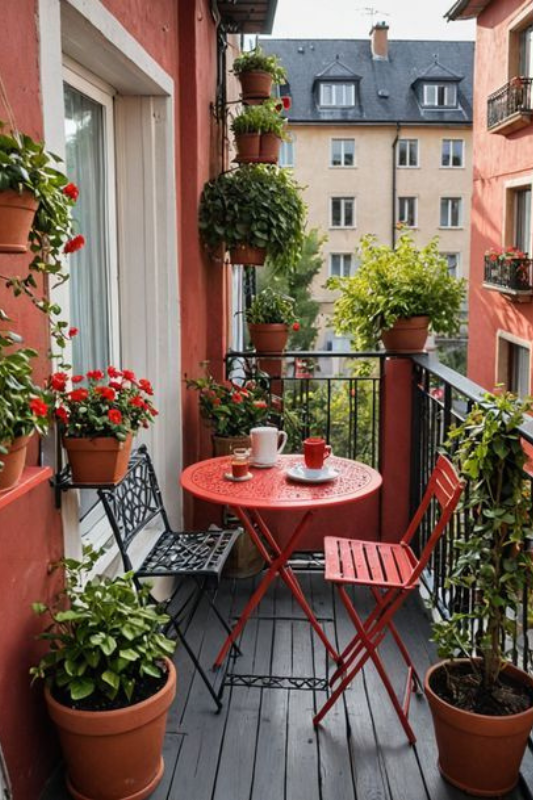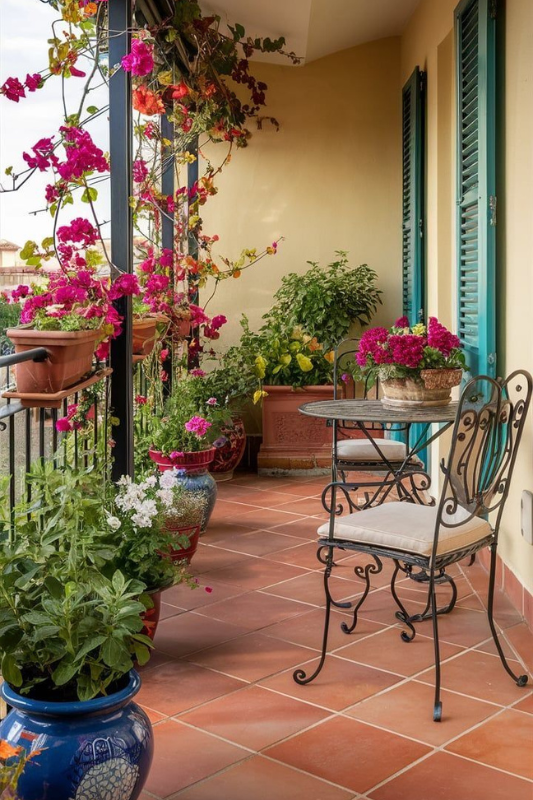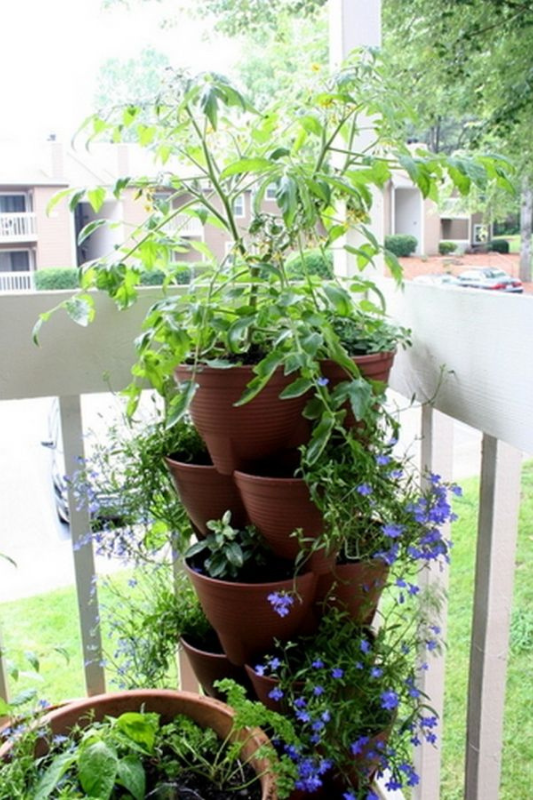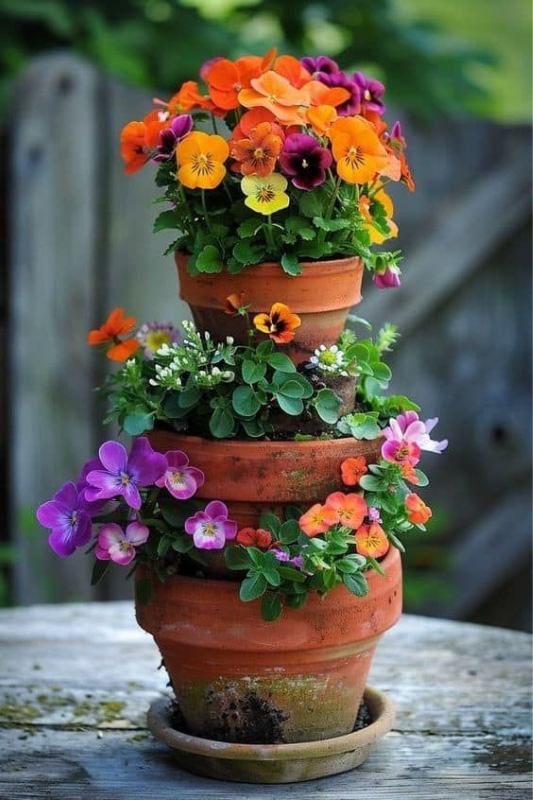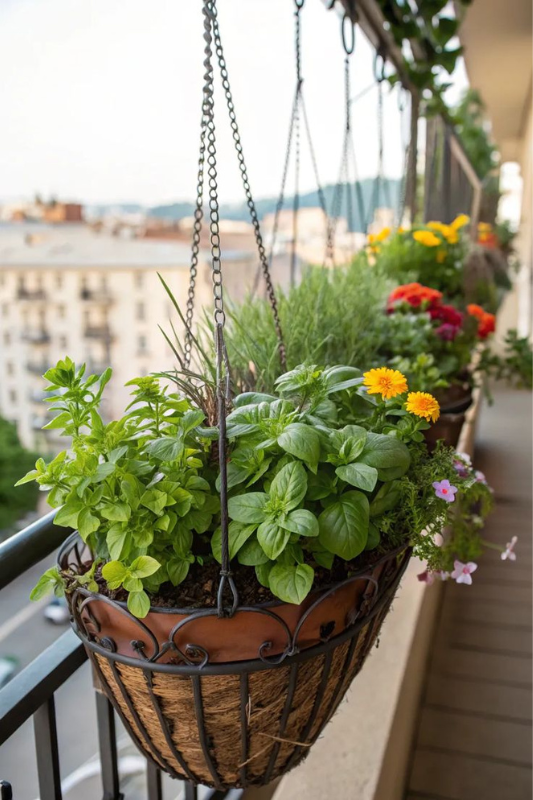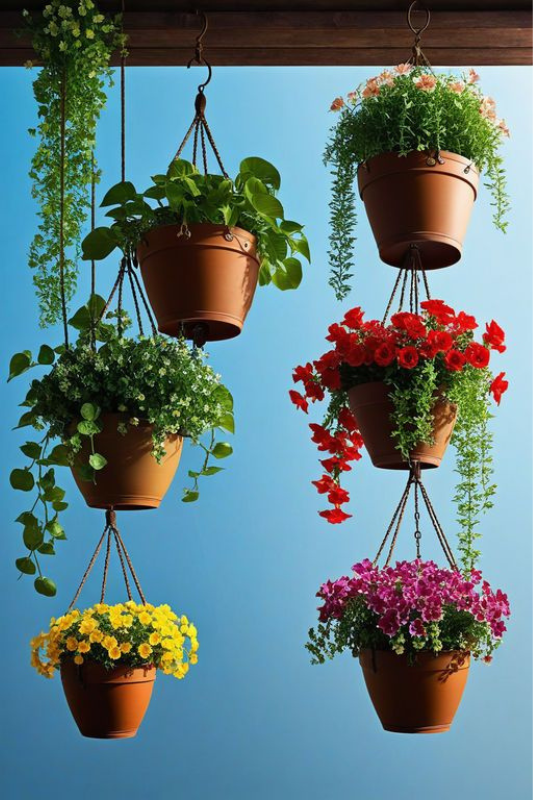Dreaming of a lush, peaceful escape just steps from your kitchen? You’re not alone. With searches for “balcony garden ideas,” “DIY balcony decor,” and “small apartment garden setups” on the rise, more people than ever are turning tiny terraces into full-blown retreats. The best part? You don’t need a backyard or even much space to make it happen.
If your outdoor space feels more like a storage corner than a sanctuary, it’s time for a reset. Whether you’ve got a slim city balcony, a compact condo patio, or just a sunny window ledge, the key isn’t square footage, it’s smart design.
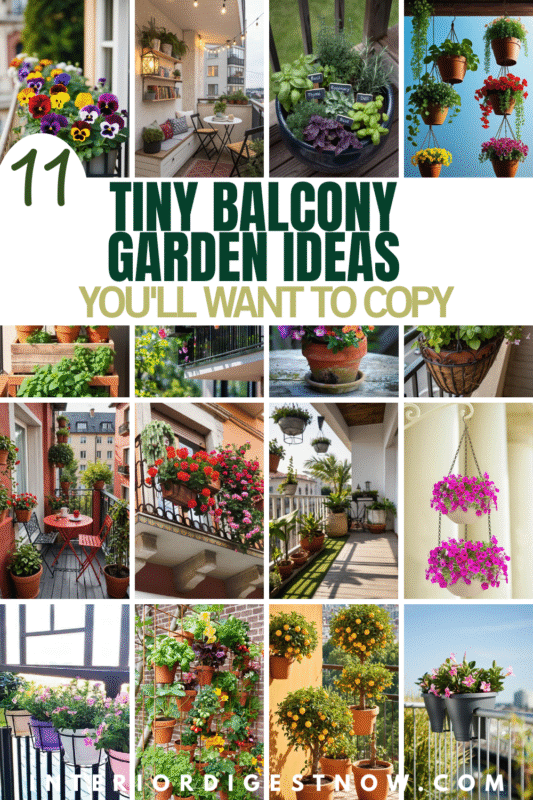
In this guide, you’ll find 11 transformative tips that blend beauty and utility: from vertical planters and hanging gardens to balcony water features and edible herb walls. You’ll learn how to create your own oasis with space-saving furniture, lighting that adds magic after dark, and even small-space composting hacks that bring sustainability to your doorstep.
So if you’ve been searching for how to turn your tiny outdoor area into your favorite room in the house, this is it. Read on and discover how to turn your balcony into a garden you’ll never want to leave.
1. Vertical Gardens
When your garden space is more vertical than horizontal, vertical gardens are the ultimate game-changer. They let you stack plants on walls, fences, or railings, freeing up precious ground for seating or pathways. Beyond their space-saving superpowers, they create a living wall that’s as gorgeous as it is functional, a cascade of green that softens hard edges and makes your tiny spot feel alive.
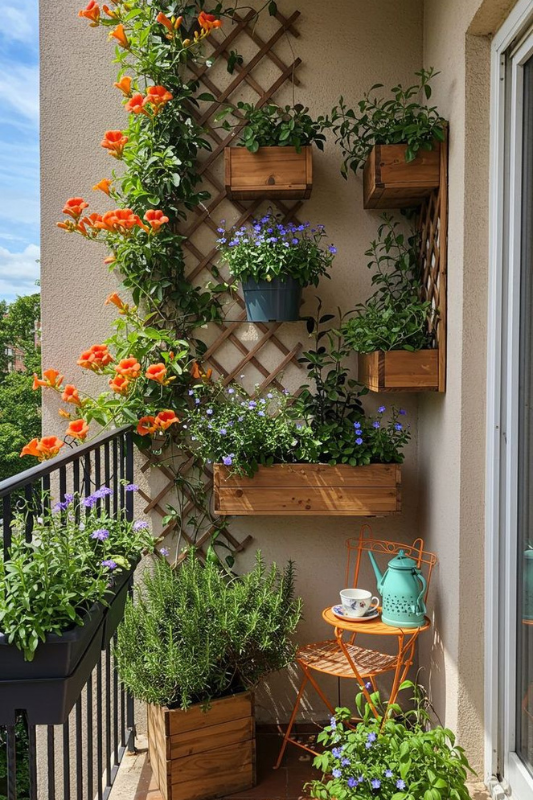
Clever Ways to Go Vertical
-
Trellises: Mount a wooden or metal trellis against a wall or fence. Climbers like sweet peas or morning glories will scramble up, turning a blank surface into a floral masterpiece.
-
Wall-Mounted Planters: Bolt sturdy boxes or fabric pockets to a sunny wall. Fill them with herbs like thyme, rosemary, or oregano, or trailing plants like ivy and nasturtiums.
-
Hanging Pots: Suspend baskets from your ceiling or railing. Petunias, ferns, or strawberries spill over beautifully, adding overhead charm.
Step-by-Step Guide to Your Own Vertical Garden
-
Pick Your Spot: Look for a wall with good light sun for succulents, shade for ferns.
-
Choose Your Setup: Trellis, hanging pots, or planters? Pick what fits your space.
-
Select Plants: Use light-loving or shade-tolerant varieties based on your orientation.
-
Plant Up & Water Smart: Fill planters, water deeply but infrequently, and mulch to retain moisture.
-
Maintain: Prune and rotate seasonally.
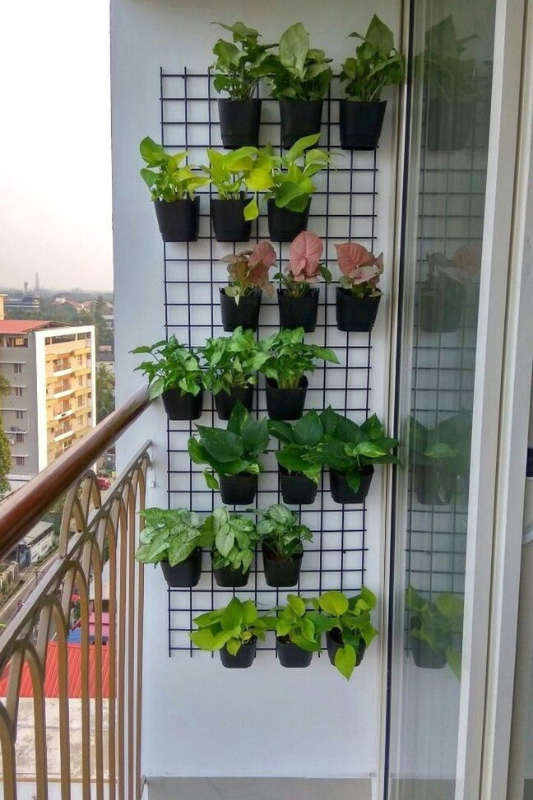
Why Vertical Gardens Shine
They maximize space, reduce pests, improve airflow, and act as stunning privacy screens. The right plant combos can even perfume your balcony.
Plant Picks and Care Tips
Use echeveria or sedum in sun, peace lilies in shade. Water regularly because vertical gardens dry fast. My first vertical wall had strawberries and mint which was really delicious and beautiful.
2. Balcony Rail Planters
One of the simplest and most effective ways to green up a tiny balcony is by using rail planters. These planters hook directly over balcony railings, letting you grow flowers, herbs, or even compact veggies without taking up a single square inch of floor space. They’re ideal for renters, too easy to install, easier to love.
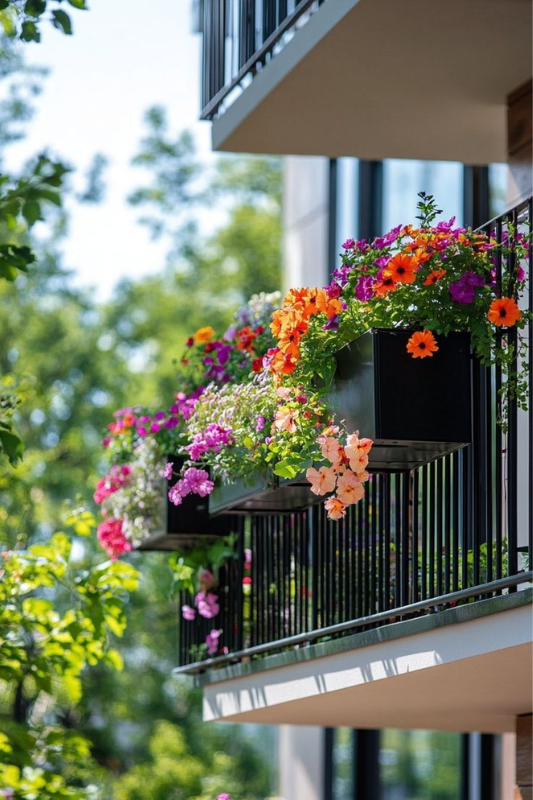
Creative Ways to Use Railing Planters
-
Color Blocks: Choose a series of planters in one bold color (like cobalt blue or terra cotta red) for a modern, unified look.
-
Herb Rows: Grow culinary herbs like basil, parsley, and thyme for a fragrant, edible balcony border.
-
Cascading Greens: Fill them with trailing plants like creeping Jenny, lobelia, or verbena that spill over the sides for a soft, lush edge.
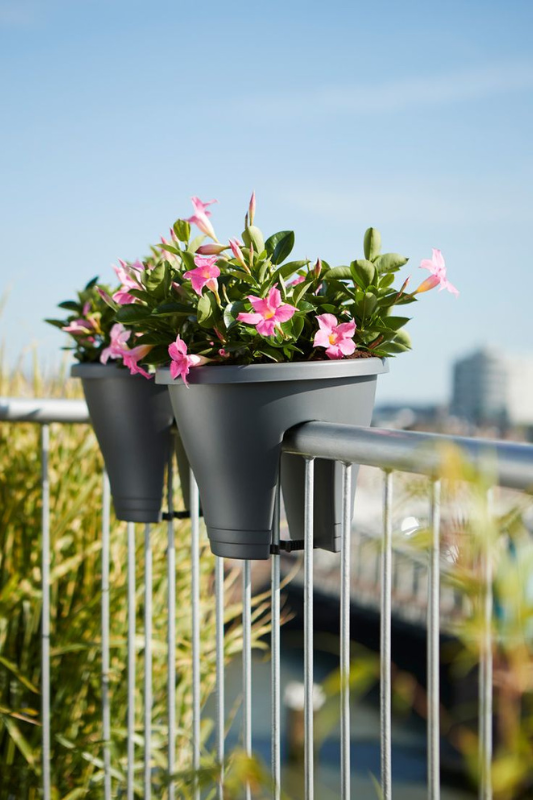
Step-by-Step Guide to Your Railing Garden
-
Measure First: Ensure your railing width matches the planter’s brackets or hooks.
-
Secure Firmly: Install with adjustable hooks or zip ties if needed for extra stability in wind.
-
Select the Right Soil: Use a lightweight potting mix with good drainage balconies often get hot, and compacted soil bakes plants.
-
Sun or Shade?: South-facing railings are great for sun-lovers; east or west-facing might suit shade-tolerant flowers better.
-
Water Wisely: Use a watering can with a long spout to reach easily or install drip tubing for no-fuss hydration.
Why Railing Planters Work So Well
They provide instant greenery at eye level, creating a garden border in the sky. Plus, they’re easy to switch out seasonally. plant pansies in spring, petunias in summer, ornamental kale in fall.
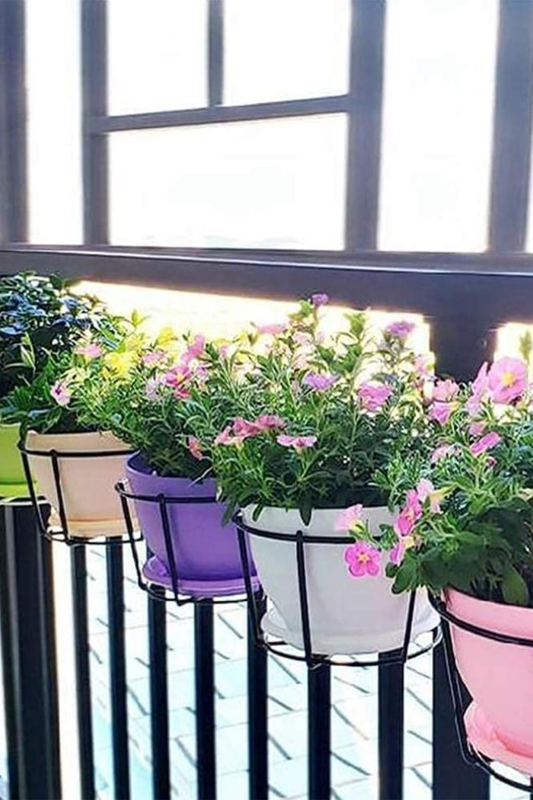
Top Plant Picks
Try sweet alyssum for fragrance, nasturtiums for edible color, or compact cherry tomatoes if your balcony gets strong sun.
3. Compact Container Groupings
Grouping a few carefully chosen containers together can make even the smallest balcony feel lush and curated. Think of it as designing a miniature garden room, each pot adds texture, color, and purpose. The secret lies in scale, cohesion, and plant selection.
Smart Ways to Group Containers
-
Rule of Threes: Arrange pots in odd numbers (three or five) for a natural, balanced look. Mix heights and widths for visual interest.
-
Themed Combos: Try a “pizza garden” with basil, oregano, and tomatoes, or go tropical with ferns, caladiums, and peace lilies.
-
Color Cohesion: Stick to a palette terracotta, matte black, or a pastel scheme to create a unified aesthetic without crowding the space.
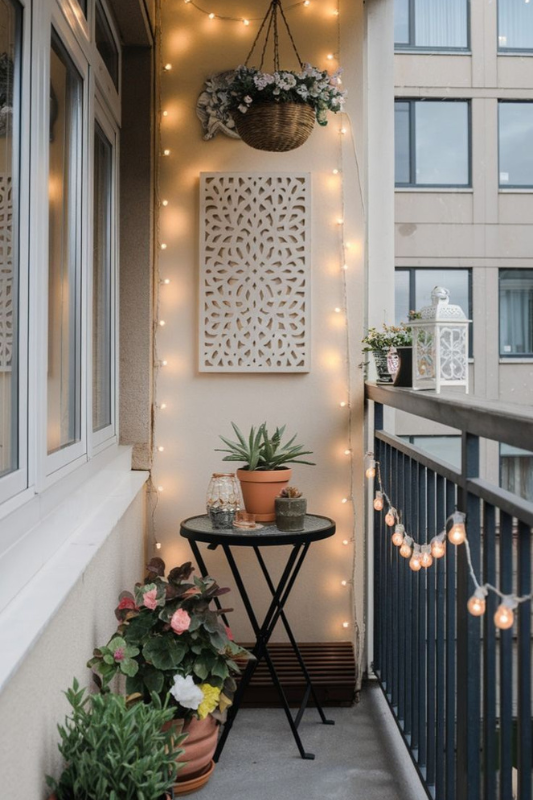
Step-by-Step Guide to Building Your Container Cluster
-
Pick a Corner: Use the edge of your balcony or a sunny spot to anchor your cluster.
-
Mix and Match: Combine tall focal plants (like rosemary or dwarf palms) with mid-sized fillers (like begonias) and trailing edges (like sweet potato vine).
-
Elevate Strategically: Use plant stands, upturned crates, or nesting tables to stagger heights and prevent a cluttered look.
-
Soil Matters: Choose potting soil with moisture control for hot balconies, and line pots with coffee filters to prevent soil loss.
-
Watering Made Easy: Group plants with similar water needs and add a large saucer or tray underneath to catch runoff.
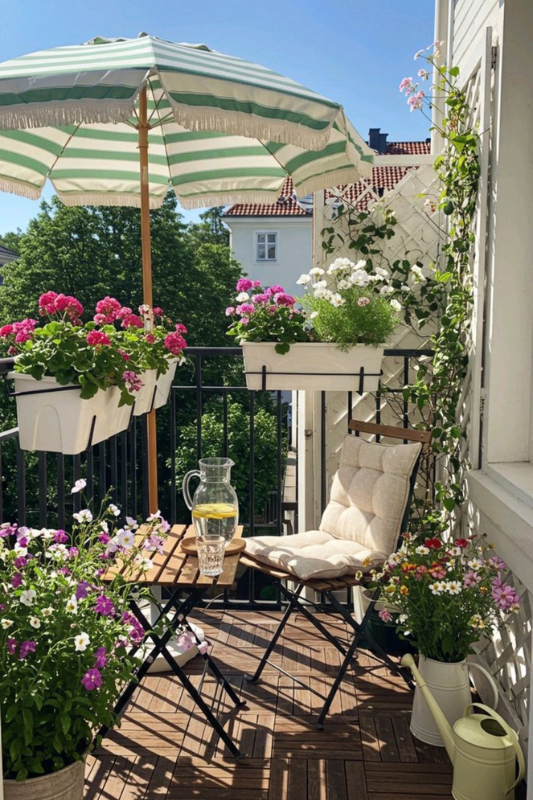
Why Container Groupings Transform Small Spaces
They’re versatile, easy to rearrange, and perfect for renters. Plus, they let you build vertical interest and thematic moments, like a calming green zone or a mini pollinator patch.
Best Plants for Grouping
Try mixing coleus for color, trailing ivy for texture, and a central lavender or dwarf citrus tree as a fragrant anchor.
4. A fragrant, edible balcony corner
There’s nothing like snipping fresh basil or mint just steps from your kitchen. A tiny balcony herb garden doesn’t just add greenery, it adds function, aroma, and charm. Whether you’re a gourmet cook or just love the smell of rosemary in the air, herbs are a must-have for micro gardening.
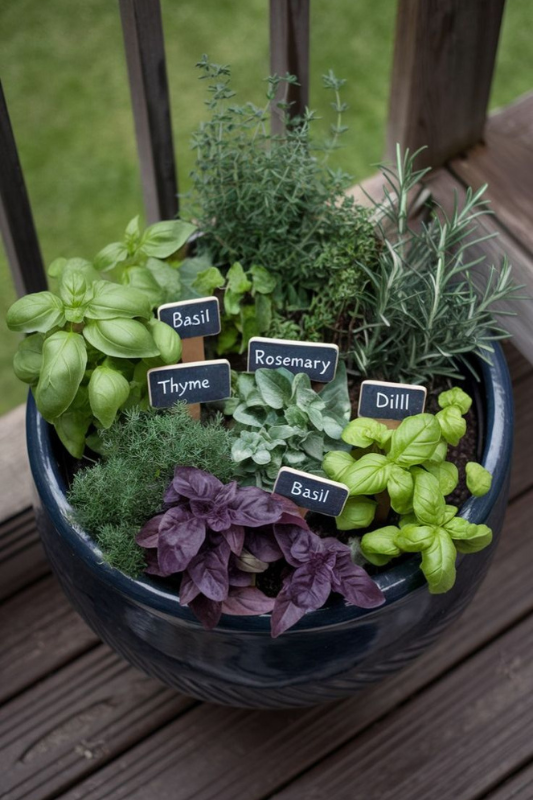
Creative Ways to Grow Herbs on a Balcony
-
Rail Planter Rows: Use narrow trough planters hung on balcony railings to grow compact herbs like chives, oregano, or thyme.
-
Stackable Herb Towers: These multi-level planters let you grow six to ten types of herbs in one square foot, ideal for serious foodies.
-
Window Box Gardens: Place a long planter along your sunniest ledge and fill it with Mediterranean herbs like sage, marjoram, and lavender.
Step-by-Step Guide to a Balcony Herb Garden
-
Choose Your Herbs: Start with 3-5 that you actually use in cooking. Basil, mint, and parsley are beginner-friendly and fast-growing.
-
Find the Right Light: Most herbs love full sun (6+ hours), but mint and cilantro can tolerate part shade.
-
Container Prep: Use pots with good drainage, and fill with a mix of potting soil and perlite or sand to improve airflow.
-
Watering Schedule: Herbs in pots dry out faster, check soil daily and water when the top inch feels dry.
-
Snip and Use: Regular harvesting encourages more growth, don’t be shy about cutting back!
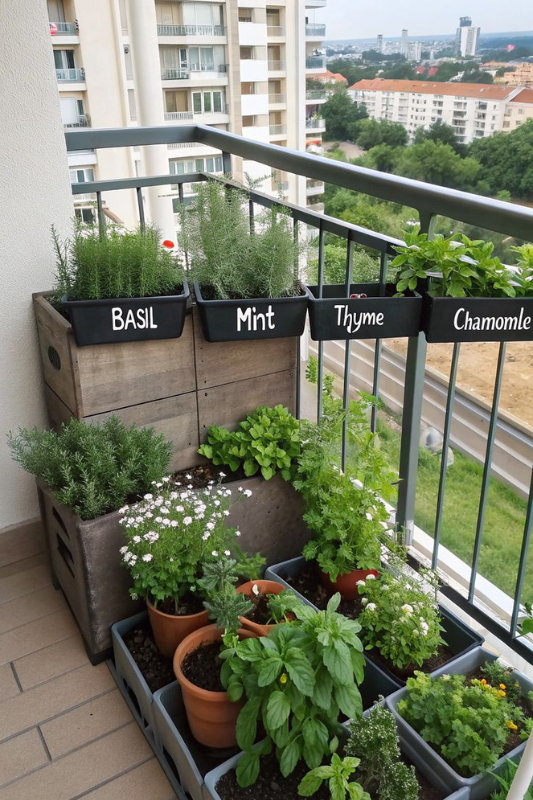
Why Herbs Are Balcony Gold
They’re compact, beautiful, and endlessly useful. Plus, they attract pollinators and can deter some pests with their aromatic oils.
Top Herb Picks
For sun: basil, thyme, oregano, rosemary. For partial shade: mint, chives, cilantro, lemon balm.
5. Miniature Trees and Dwarf Varieties
You don’t need a backyard orchard to enjoy the presence of a tree. Miniature trees and dwarf plant varieties are perfect for balconies. They bring structure, shade, and even fruit, all while fitting snugly into a pot. They’re also visually grounding, giving your small space a real garden feel.
Smart Ways to Use Small Trees in Containers
-
Dwarf Fruit Trees: Try a potted Meyer lemon, fig, or dwarf apple for fresh produce and beautiful blooms.
-
Evergreens for Privacy: Columnar conifers like dwarf Alberta spruce or sky pencil holly add year-round greenery and act as natural screens.
-
Ornamental Options: Japanese maples or olive trees bring stunning foliage and texture without overtaking your balcony.
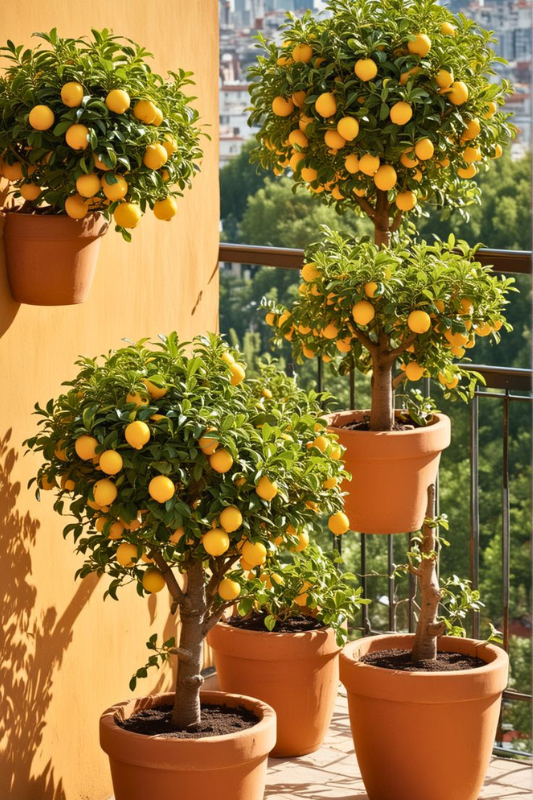
Step-by-Step Guide to Growing Trees in Small Spaces
-
Pick the Right Pot: Use a large, deep container with drainage holes, trees need room to root. Clay or ceramic helps with stability in wind.
-
Soil and Drainage: Use a loamy, well-draining potting mix blended with compost. Add a layer of gravel or pot feet to help drainage.
-
Placement: Position where the tree gets 6–8 hours of sun. Rotate occasionally for even growth.
-
Watering: Check soil regularly. Trees in pots dry out faster than ground-planted ones. Deep water once or twice a week, depending on heat.
-
Prune to Shape: Trim for size and shape control. Remove any suckers or dead branches to keep your tree looking tidy.
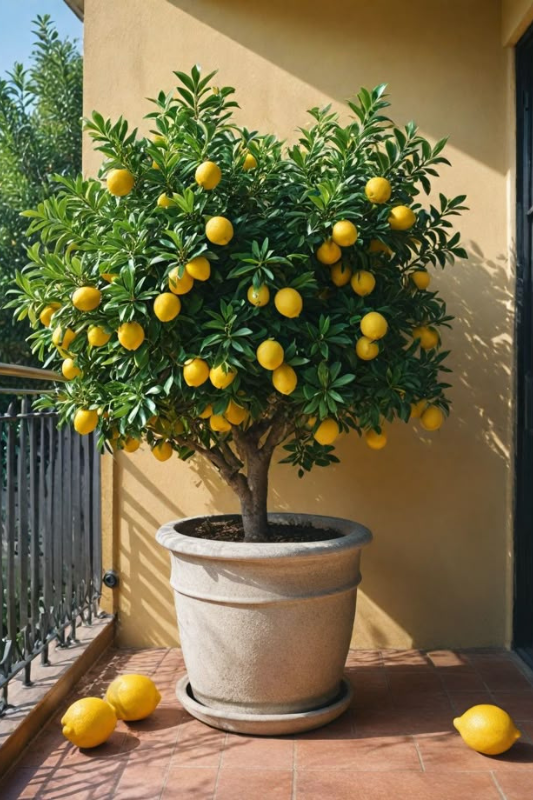
Why Dwarf Trees Work So Well
They create a sense of permanence and maturity in a compact space. Plus, flowering or fruiting varieties deliver a sensory experience, sight, scent, and even taste.
Top Tree Picks
Try dwarf citrus (if your climate allows), Japanese maple for beauty, or a small fig tree for bold leaves and sweet fruit.
6. Balcony Edging with Low Planters
One of the most overlooked tricks in small balcony gardening is using low, continuous planters along the edges. Instead of cluttering the middle with pots, you frame your space, creating visual flow, soft privacy, and a more “complete” garden feel. It’s subtle, strategic, and seriously effective.
Clever Ways to Edge Your Balcony Garden
-
Box Planters: Line the perimeter with rectangular planters that sit flush against the railing ideal for ornamental grasses, pansies, or herbs.
-
Modular Sections: Use stackable or interlocking boxes that curve with your balcony layout.
-
Seasonal Rotation: Change out edging plants with the seasons use spring bulbs, summer annuals, fall cabbages, and winter evergreens.
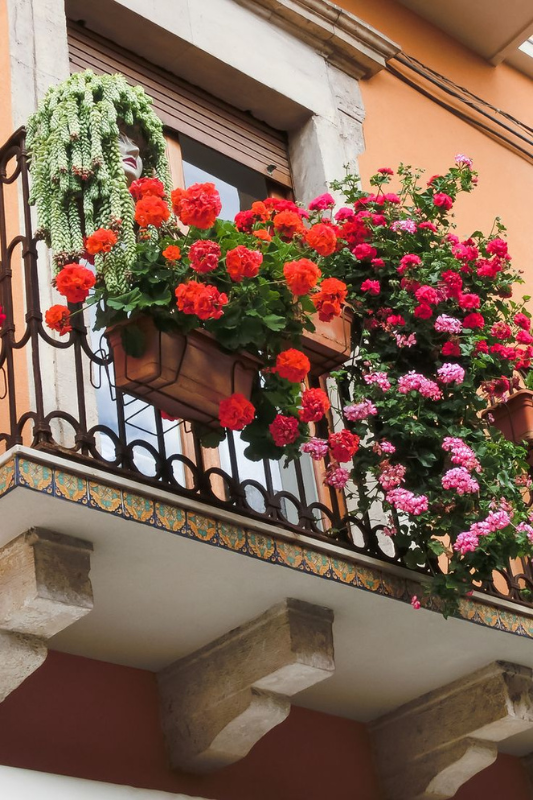
Step-by-Step Guide to Planting an Edged Balcony Garden
-
Measure Your Rail: Choose planters that don’t eat into your usable floor space. Shallow, long boxes work best.
-
Plant Selection: Go for a mix of trailing plants (like creeping Jenny or calibrachoa) and upright textures (like coleus or dwarf fountain grass).
-
Drainage Planning: Elevate planters slightly with pot feet to avoid water pooling and staining your balcony.
-
Consistent Color Scheme: Stick to 2–3 harmonious tones across the edge for a cohesive, calming border.
-
Accessibility: Leave a gap near doorways or seating zones to maintain open flow and reduce tripping hazards.
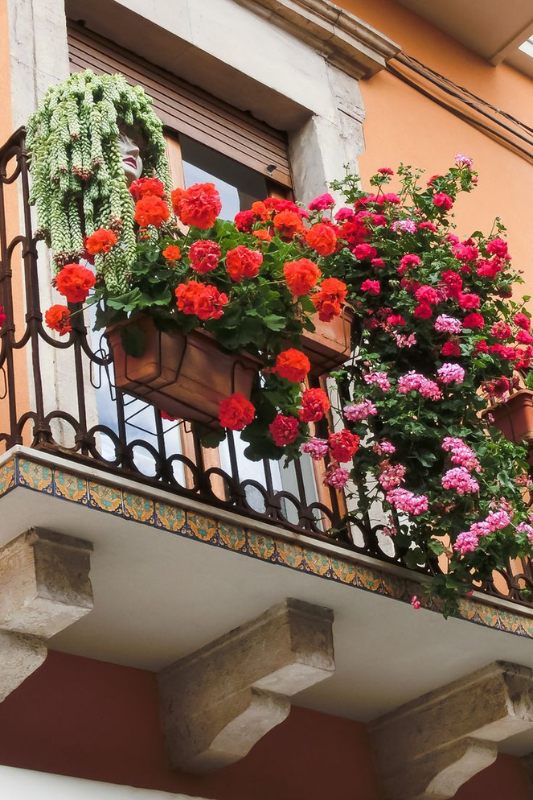
Why Balcony Borders Are Brilliant
They create a sense of enclosure and intimacy like walls of green instead of fencing you in. It’s structure without heaviness.
Top Picks for Balcony Edging
Go for ornamental kale, mini petunias, sweet alyssum, dwarf lavender, or creeping herbs like thyme and oregano.
7. A chic shaded nook on a sunny balcony
Balconies often come with unfiltered sun exposure which can scorch plants, overheat your space, and make it unusable during peak hours. Creating partial shade not only protects your plants but also makes your balcony comfortable year-round.
Creative Ways to Add Shade to a Balcony Garden
-
Retractable Awnings or Shade Sails: Mount a canvas sail or install a foldable awning to create flexible coverage without blocking airflow.
-
Outdoor Curtains: Hang UV-resistant fabric panels from tension rods or hooks to soften light and add privacy with a breezy, resort-style look.
-
Umbrella Hacks: Use half umbrellas or offset cantilever umbrellas that tuck against walls, perfect for narrow balconies.
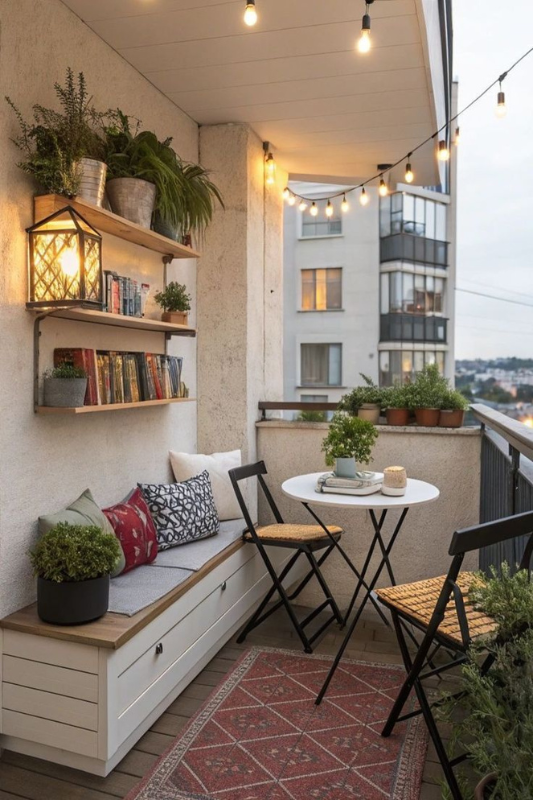
Step-by-Step Guide to a Shady Balcony Oasis
-
Assess the Sun: Track how many hours of direct sun your space gets, most plants prefer 4–6 hours of indirect light.
-
Install Hardware: For awnings or curtains, ensure your railing or ceiling can hold weight, use adjustable mounts where drilling isn’t allowed.
-
Plant Accordingly: Group shade-loving plants under your cover, think caladiums, begonias, hostas, or ferns.
-
Cool the Floor: Lay down a bamboo mat or outdoor rug to absorb heat and prevent surface glare.
-
Ventilation Check: Leave gaps for air circulation to prevent stagnant heat or humidity buildup.
Why Shade Makes a Huge Difference
It extends your balcony’s usability and helps prevent sunburned leaves or wilting plants. It also instantly turns your space into a chill-out zone, especially welcome in urban heat zones.
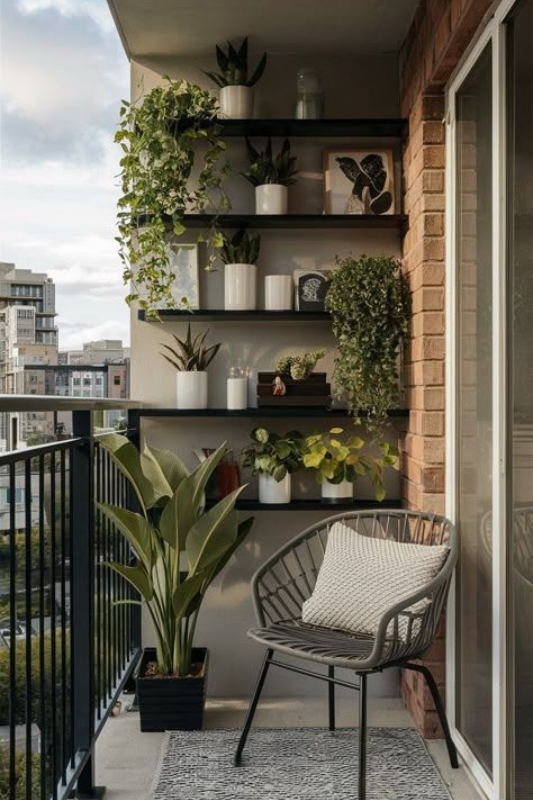
Top Plant Picks for Shade
Try impatiens, coleus, hosta, Boston fern, and Chinese evergreen for lush under-cover beauty.
8. Low-Maintenance Greenery
Busy schedule? Black thumb? No problem. Some plants are practically unkillable—perfect for beginner gardeners, frequent travelers, or anyone craving a green space without the pressure.
Low-Maintenance Plant Picks
-
Snake Plant: Stylish and tough—thrives on neglect.
-
Pothos: Grows fast, tolerates low light, and trails beautifully.
-
Zebra Haworthia: A small succulent that loves sun and forgetful watering.
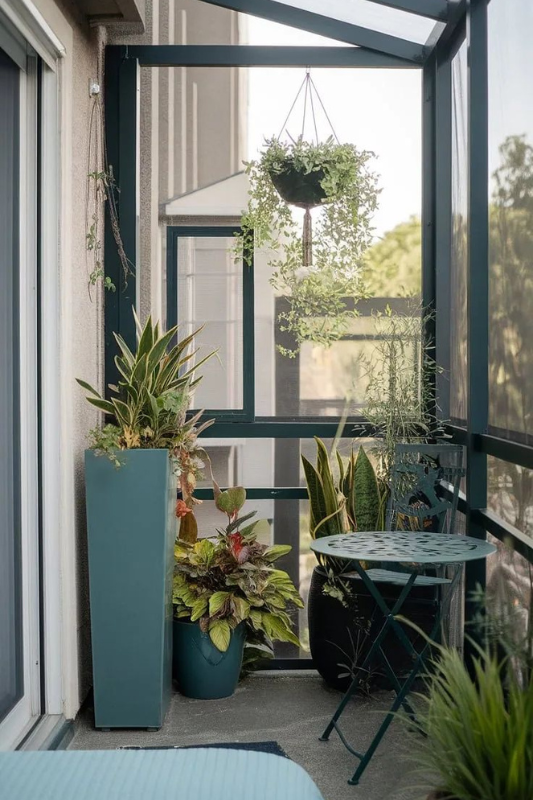
Steps to Low-Maintenance Success
-
Pick the Right Containers: Use self-watering pots or add mulch to retain moisture.
-
Keep Soil Consistent: Use cactus mix or well-draining potting soil for all-in-one ease.
-
Set Reminders: Use phone alerts or smart watering bulbs to avoid over/underwatering.
-
Feed Lightly: Fertilize just once every 1–2 months.
-
Avoid Fuss: Skip finicky flowers—stick to foliage that stays lush with minimal care.
Why It Works
It gives you the joy of a green space with zero stress. Your balcony looks vibrant—even if you forget to water for a week.
9. Balcony corner styled like a Mediterranean escape or jungle retreat
Create the Balcony Garden You Have Always Wanted
Your balcony holds more potential than you might think. With the right small balcony garden ideas, you can transform even the smallest outdoor corner into a peaceful space filled with greenery, color, and personality. Whether you are growing herbs, adding vertical planters, or decorating with cozy furniture and soft lighting, every detail brings your vision to life.
Use vertical gardening to save floor space, choose plants that thrive in pots, and arrange your seating to make the most of the light. A balcony garden can be both practical and beautiful. It is a place to sip your morning coffee, unwind in the evening, or simply enjoy a moment of quiet surrounded by plants.
Start simple. Add one or two things you love. Watch your outdoor space come to life and turn into a garden that feels just right for you.
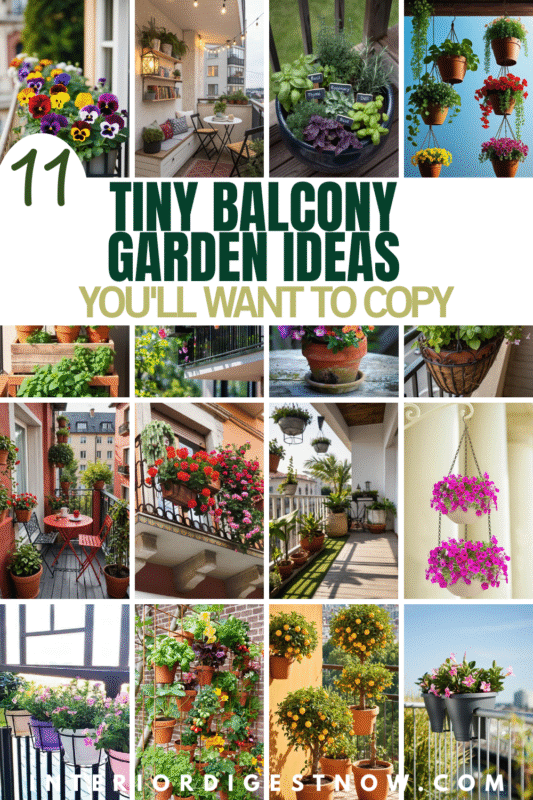
This post showed you the 11 Tiny Garden Decor Ideas That Make a Big Impact.

